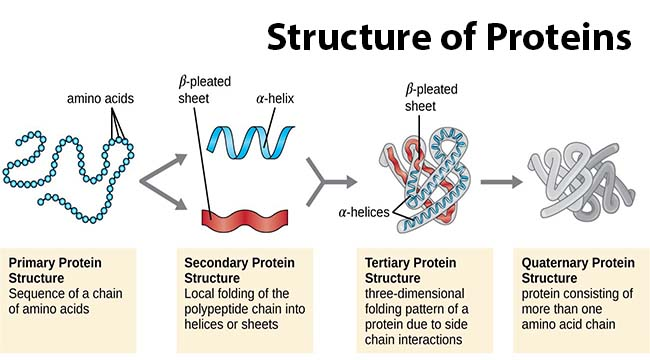Structure of proteins – primary, secondary, tertiary structure and quaternary
Proteins are functional biological molecules, made up of polypeptides and are coiled to the specific structures. They serve as transportation channels, as enzymes, transmitters, structural elements, and signal receptors. Every protein has a unique sequence and describes the structure and the functions of proteins. Based on structure, they are classified into four types, which will be discussed in this article.

Primary structure
Its formation is in the unique order, by which the amino acids are linked and combines to make the protein molecule. Proteins get all the properties from the primary structure. For the protein structures, it is the simplest level. A specific sequence of amino acids is represented by the primary structure of the proteins. The position of two amino acid molecules in such a way that carboxyl groups of all amino acids are adjacent to each other reveals the primary structure. A dehydration reaction also results in their combination and causes the formation of a peptide bond.
Secondary Structure
In the secondary structure of the proteins, the peptide backbone of the protein’s structure is folded onto itself and gives the unique shape to the proteins. These polypeptide chains are folded due to the interaction between amine groups of the peptide chains, and carboxyl groups. In the secondary structure, two kinds of shapes are formed, alpha helix, and beta-pleated sheet. In alpha helix, the backbone of protein follows a helical structure, and in between the different layers of helix hydrogen bonds with the oxygen and as a result helical structure is produced. The chains of polypeptides are stacked next to each other in the beta-pleated sheets and intramolecular bond is formed by the hydrogen molecule, which attributes the sheet-like structure to the protein.
Tertiary Structure
The tertiary structure gives the 3D shape and formation of the protein structure. After the formation of the bonds, by the amino acids, and shapes like the sheets and the helices, the structure can be randomly folded or coiled. If the tertiary structure is disturbed or disrupted, protein is regarded as denatured indicating that its structure is distorted and it is chemically affected.
Quaternary Structure
This structure is formed by the spatial arrangement of two or more than two peptide chains. For proteins, it is not necessary to have a quaternary structure. Other structures are present in all of the proteins, but for quaternary structure, there is no specification. So, if a protein does not have the quaternary structure, it will be counted as protein.